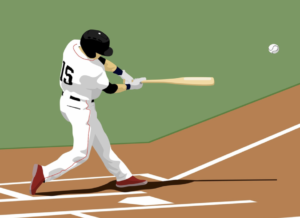Command of the strike zone (Part 1-Hitters)
October 8, 2021 by Coach McCreary
Filed under Hitting
In the summer of 1988, I was fortunate to play in the Cape Cod League (Falmouth, MA). Top players from around the country converge on the coast of Massachusetts to play some pretty high-level baseball.
The Cape was also one of the only summer leagues that required wood bats. This created two challenges for me. One was having to face top-notch pitching every night. The second was getting used to wood bats which I hadn’t used since Little League. I will admit, the first week or so was quite the disaster. I broke numerous bats (even during BP!) and seriously began to doubt whether I was going to make it up there. I realized that something had to change.
I ended up making the mid-season All-Star game as a shortstop so obviously adjustments were made and things worked out.
What was the change?
Answer: Better command of the strike zone.
The more bats I broke, the more I noticed that most of the time I broke them when I swung at a pitch out of the zone. With a metal bat, a ball just off the plate and off the end of the bat could result in a line drive single or double. When I tried to do that with a wood bat it resulted in a weak grounder or pop-up and usually me holding what remained of a shattered bat. I also noticed that I was also breaking bats on pitches in the zone that could be labeled “pitcher’s pitches.” In a 1-0 count, I’d swing at any pitch in the strike zone. A pitch on the inside corner and elevated would be a strike but it would also jam me resulting in a cracked bat. Going through all that several times not only shattered my bat. It shattered my ego as well.
This all forced me to develop much better plate discipline and command of the strike zone. I began to take those pitches just off the plate or up and in. I began to develop a better game plan which included giving certain parts of the plate to the pitcher until I got to two strikes. Instead of “swinging at strikes,” I began to be more patient and “swing at pitches I was best suited to handle.” In short, my hitting approach vastly improved.
As you get older, the pitchers you face become tougher to hit. They start using both sides of the plate instead of just the outer half. They throw multiple pitches for strikes instead of just a fastball. They change speeds more effectively and you start to see more off-speed pitches in fastball counts. When this happens, hitters have to adjust or they will be forced to find another hobby. Thankfully, I didn’t have to just yet.
A true strike zone is roughly a 17 inch x 24 inch rectangle which makes it an area of about 3 square feet. Success at hitting at the lower levels depends largely on making the pitcher throw the ball within those 3 square feet. At the higher levels it is not that simple. Some pitchers are so talented that you cannot possibly cover all 3 square feet on every pitch. Their stuff is too good. Hitters are forced to break up the strike zone into areas. 1) The area(s) where they have the most success when swinging and/or, 2) The area(s) where the pitcher is most likely to throw the ball. That requires some prior thought and observation on the part of the batter.
What are my strengths? What part of the strike zone do I handle the best? Where is this pitcher throwing the ball? What area(s) does he use to get ahead? What area(s) does he use to put hitters away? In what area does his breaking pitch start and in what area does it end up?
The answers to all these questions are different for every hitter / pitcher. They also provide valuable information for hitters who need to develop better command of the strike zone to improve their hitting performance.
Good Little League hitters don’t typically have to worry about all this. Their natural physical talents allow them to succeed without much thought. However, sooner or later they will start to run into other talented players that won’t allow that approach to work as easily.
This off-season, feel free to work on your swing but don’t neglect your work in learning how to have better command of the strike zone. Your future in the game depends on it.
If you liked this post, please SHARE it with three people: one who will like it, one who needs to see it, and even someone who you think won’t like it!
Thanks for reading!
Coach McCreary’s Bio Page: https://www.BaseballByTheYard.com/bio
Coach McCreary’s YouTube Channel: https://www.youtube.com/channel/UCtli…
Coach McCreary’s Resource page for Players and Coaches: https://www.BaseballByTheYard.com/res…
Instructional eBooks and videos: https://bytheyard.gumroad.com






Leave a Reply